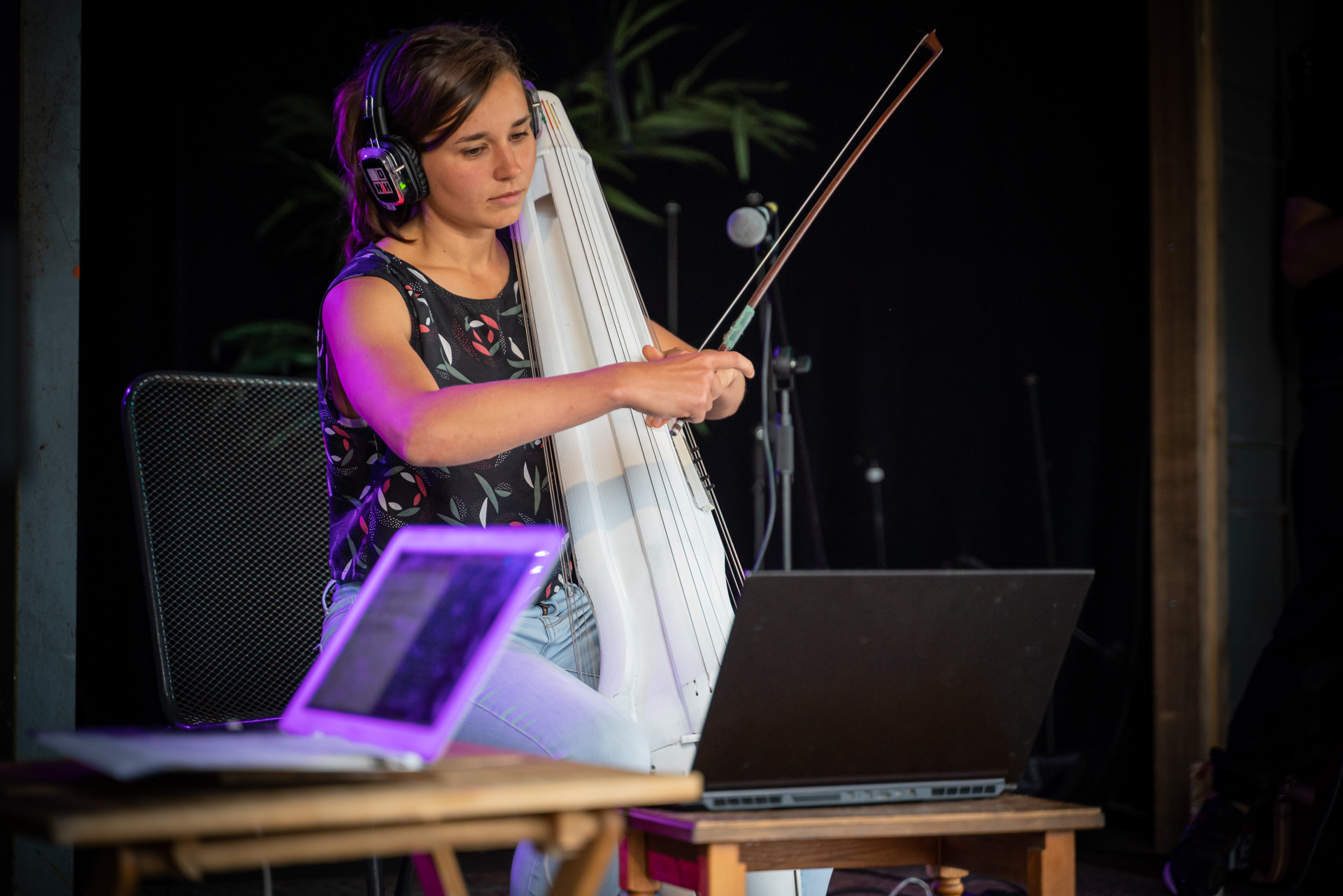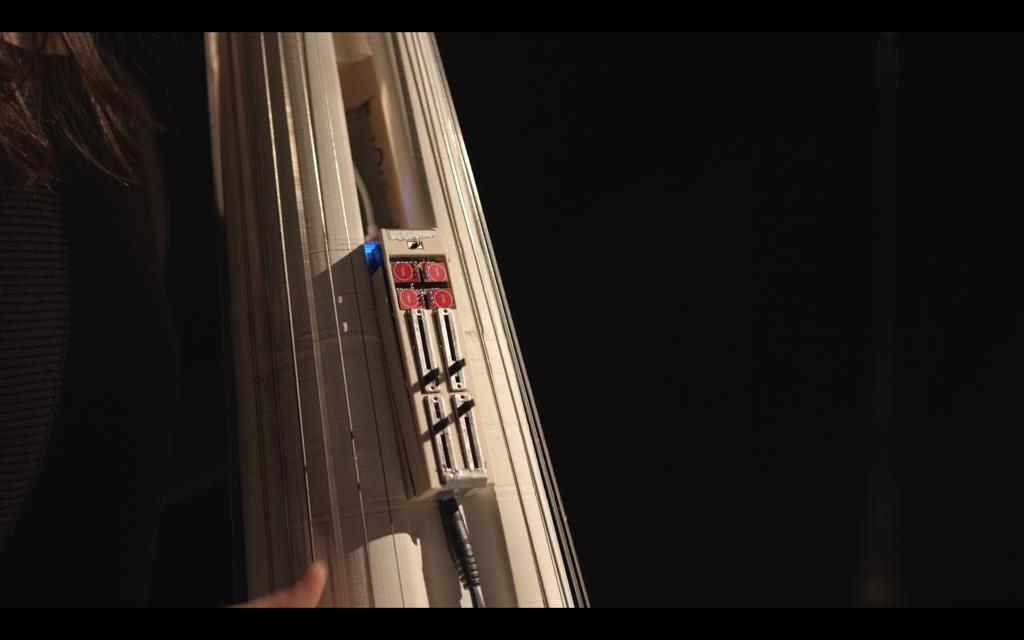‘I like to compose playing, using my joints to discover and explore the material with gestures that I am working on’ [...] (Hildur Guðnadóttir, 2021)
Since the invention of DAW systems and softwares, most music composers nowadays are stimulated to work with digital workspaces by its potential of bringing effects, plugins, instruments, workspaces, music sheets and midi simulations into a more effective and manipulative workflow for users. Our work is also premixed, live streamed and produced by digital companies all over the world. It seems those inventions had solved mostly all the problems for a composer to make its own music. However, there is one tiny question remaining on the air: how do we make our labor visible and in contact with its listeners without owning any physical space, tool and engaged practice on using such products?
I have been seeing a lot of my friends overcoming this situation by engaging with music ensembles, where they also become multitask producers of those groups. I also saw other friends avoiding this problem by making even more complex music (I can include myself in this category), or either becoming teachers, professors, researchers, theorists, programers and so on. In any of those paths, we suffer from the same problem: the music industry has become so dynamic for its listeners that it indulges a narrower work conditions and perspective for its makers. I found out that playing and becoming a performer of my own music was a possible solution to keep nursing my career and my creative practice, since composing is an integrative practice for our hands, not only the brain.
Performing my own music has allowed me to see its process of production from start to end, it teaches me to prioritize goals and expands my vision about what belongs to music performance: its space, atmosphere , audience and the people working with you. Besides it, focus, dedication and clearance of thoughts, when developing creative content, is a skill only owned by constant practice, such as for an instrument. Like in creative writing, owning your own voice is also a hard and constant commitment that requires a lot of practice, intuition and self determination for your own sake. To develop Knurl means to me to design my creative practice for the conditions, concepts and the sounds that I am interested in exploring as a music composer.
2.1.2.1. Context
The whole investigation of bringing tools of music composition into the cellist’s hands became a long experience and a serious reflection of my creative process. With the development of Knurl, I spend most of my creative practice improvising and testing combinations of new gestures and sounds. Each moment became so special and part of a report, research or exploration.
However, at a center point of any craftsmanship, you start to aim for precision and perfectionism into the mechanisms you created. So yes, there were a lot of moments where I saw myself falling in the same trap: I became so focused on achieving certain rules or conditions imposed by settings, other musicians and performances that I forgot that my goal was only to produce music, no matter how many qualities it implies.
The perfectionism that a musical instrument design requires is a work by itself and it was a challenge to be satisfied sometimes with a certain glitchy sound of the mic or a silly or unstoppable mechanism. For months, I saw myself building iteration after iteration, never satisfied with the degree of expression that each prototype was giving to me. Somedays, I became very frustrated and afraid of this project's future. It was with the help of my family, friends and professors that I started to confront the force of making everything perfect in order to feel creative and use the instrument no matter in which status it belongs. I started slowly to enjoy its process of evolution and set goals that didn’t provoke my personal life.
With Knurl I composed during this master 4 music albums: ‘UN-BOW’ , ‘Super Organism’ , ‘In tune’ and ‘Chasing breath’, each containing between 6 or 8 Tracks. Each album had a unique process of composition and very enjoyable collaborations. Those projects were not a product of promotion: they were all sharing the goal of making me create more music. Some were also discussing some very interesting points (such as The matter’s future of an album, sustainability or Open source music), but mostly, I focused on the ability to transmit stories on each track with the sounds of my instrument.
The elements I used were pretty simple and no highly processed music was required. Some were produced in one-go, some took months after its final rendering. In this chapter, I will describe how the process of composition has changed using my instrument for it.
2.1.2.2. Starting point
One of the main goals that I felt it was important to achieve for the instrument design was to understand how a single human could listen and assist multiple sonic layers at the same time, giving for each sound the highest amount of flexibility you could find. When choosing and making the paths of its interface, I focused on interpreting the process of composition of 4 aesthetics of modern music (Programming, Synthesis, Detection and Analogue music). I realized each of those had a different way of presenting, organizing or finishing sounds and I wanted to test if that can be explored into music composition. I wanted to determine a way of thinking for each voice or sound layer.
The movement and flexibility I was chasing sonically became also a criteria for designing the mapping of the interface. With every artwork, I realized the importance of stopping, pausing, restarting one, a group or all voices. Day by day, I added those conditional elements and tested them in my practice. Therefore, The development of the interface was always tested by my creative choices making music. The interface design was revisited and constantly improved every time I was also improvising. I gave myself the possibility to always be in control of Which mode of performance was I thinking of, Who was the voice selected, What was the Action and How was it made, by leaving 4 management buttons controlling each of those needs:
By the development of each interaction, I used a switch to organize my actions between managing or running. Switching the button left or right was allowing me to have visual feedback of the internal system without having a computer screen while playing it. While the actions of managing the buttons was about organizing and selecting actions, the running mode of the 4 buttons allowed to compose and trigger sounds. A whole lists of sounds and their way of composing music was made to the configuration of the running buttons for each mode of performance, each action and subaction.
Some elements of music composition also became a criteria for its construction during the development of its iteration, such as its tuning system, interface mapping and cognitive aspects of the machine listening system. In both albums, the role of electronic sounds became a physical experience and active participation into my creative choices as a performer.
2.1.2.3. Application
In the production of Idalina, I took a great amount of time to improvise, reflect, change and rethink its whole composition. In both premieres in Italy and Gaudeamus, I decided to not accept its deadline as its final goal so that I could take my own time to develop it. At those performances I mostly improvised the contents of it. It was after 7 months of playing and improvising with the material that I started to decide to close its form. I also didn’t write any scores of it until then, It just became part of my cello daily practice.
I am not sure if this experience could be repeated in other contexts: mostly when playing with other people. You must face that some organization is necessary from the beginning. In the class of Music and dementia, for example, when we had to compose a format for improvisation, choosing a format was the first goal when improvising it. Nevertheless, this process has teached me to see my creative goals differently, it also made me understand music globally and realize that time was my best friend; the more I decide to spend working on a certain sound, the more enjoyable and interesting its combination of layers and textures becomes.
For the latest album ‘Chasing breath’, I used stories and my holidays memories as a diver to explore beyond the aesthetics that I was used to. Since the movement of the electronic sounds became quite complex, my strategy was to focus first on generating my ideas and then thinking what could I apply from this music into the interface. For each track, I programmed tasks mechanisms and after its creation and during my practice as a performer, I started to check what it fits, what could I learn from this artwork into the interface.
2.1.2.4. Findings
With Knurl, the process of selecting the ‘colors of your palette’ became beyond material: to learn my own sounds became a multi-sensorial experience combining body memorization, recognition of emotional state, body and space awareness. In my personal experience, those experiences were not easily achievable when producing scores for the sake of explaining your ideas to other musicians or rendering audio mixing by the computer to obtain great results as fast as possible. I personally enjoy learning to deal with errors and accept them as part of the performance too. Being a performer / maker of my own compositions has allowed me to prioritize and not feel limited by time in order to finish each composition for a specific concert. I think it is important to have enough time to achieve the results you want and at the same time learn to prioritize and be flexible to the conditions of the people you serve.
I am still curious to reach a great level of understanding and simplicity on Knurl, integrating skills that could allow flexibility and more artistic expression. However, at some point of this research It was more important to accept the sounds I already had, instead of trying or aiming to achieve something else. During the production of those 3 albums, I sensed that most successful tracks were the ones where I was improvising constantly with a material that was ready into the interface. As a composer, to integrate my music practice became reachable when I started to play to practice how the sounds were organized or maintained, and not only produced. Not creating, but to learn how to use it. In this way, every idea became part of a unique process and workflow.

